

YouTube Playlists for Learning Programming. Memory Management Reference: Frequently Asked Questions. This is a list of questions that represent the problems people often have with memory management.
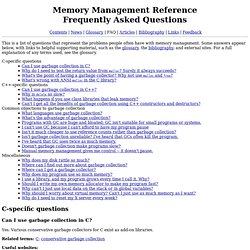
Some answers appear below, with links to helpful supporting material, such as the glossary, the bibliography, and external sites. For a full explanation of any terms used, see the glossary. C-specific questions C++-specific questions Common objections to garbage collection Miscellaneous C-specific questions Can I use garbage collection in C? Yes. Related terms: C; conservative garbage collection Useful websites: Boehm-Weiser collector <URL: Why do I need to test the return value from malloc? For small programs, and during light testing, it is true that malloc usually succeeds. Someone uses your program for a far larger data set than you anticipated; Your program is running on a machine with less memory than you expected; The machine your program is running on is heavily loaded. Advanced Programming Languages. Introduction Research Syntax Semantics Static Semantics ( Type Theory ) Dynamic Semantics Semantic Related Developments Abstract Interpretation Program Transformation Decompilation Partial Evaluation.
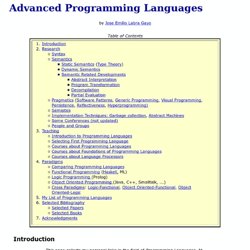
UW CSE Courses on the Internet. Great Works in Programming Languages. In September, 2004, I posted a query to the Types list asking people to name the five most important papers ever written in the area of programming languages.
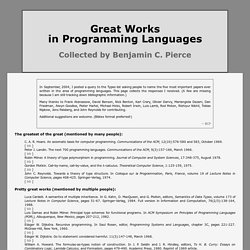
This page collects the responses I received. (A few are missing because I am still tracking down bibliographic information.) Many thanks to Frank Atanassow, David Benson, Nick Benton, Karl Crary, Olivier Danvy, Mariangiola Dezani, Dan Friedman, Alwyn Goodloe, Pieter Hartel, Michael Hicks, Robert Irwin, Luis Lamb, Rod Moten, Rishiyur Nikhil, Tobias Nipkow, Jens Palsberg, and John Reynolds for contributing. Additional suggestions are welcome. (Bibtex format preferred!)
The greatest of the great (mentioned by many people): C. Peter J. Robin Milner. Gordon Plotkin. John C. Pretty great works (mentioned by multiple people): Luca Cardelli. Mobile Computing with iPhone and Android. Hallmarks of a Great Developer - Test Guide. If you ask me, I'll tell you a great developer Plans before coding A great developer takes the time to plan an approach before designing or coding.
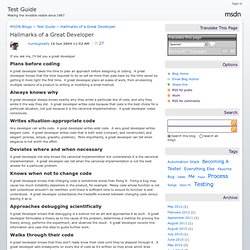
A great developer knows that the time required to do so will be more than paid back by the time saved by getting it more right the first time. A great developer plans all scales of work, from envisioning multiple versions of a product to writing or modifying a small method. Always knows why A great developer always knows exactly why they wrote a particular line of code, and why they wrote it the way they did. Writes situation-appropriate code Any developer can write code. Deviates where and when necessary A great developer not only knows the canonical implementation but understands it is the canonical implementation. Knows when not to change code. Free Programming and Computer Science Books.
Programmer's Heaven - Ruby, .NET, C#, C++, PHP, Python, Java - It's all here! Structure and Interpretation of Computer Programs. Hot Scripts - The net's largest PHP, CGI, Perl, JavaScript and ASP script collection and resource web portal. Pointer Basics. This document introduces the basics of pointers as they work in several computer languages -- C, C++, Java, and Pascal.

This document is the companion document for the Pointer Fun with Binky digital video, or it may be used by itself. This is document 106 in the Stanford CS Education Library. This and other free materials are available at cslibrary.stanford.edu. Some documents that are related to this one include... Section 1 -- Pointer Rules One of the nice things about pointers is that the rules which govern how they work are pretty simple. 1) Pointers and Pointees A pointer stores a reference to something. The above drawing shows a pointer named x pointing to a pointee which is storing the value 42. Allocating a pointer and allocating a pointee for it to point to are two separate steps. 2) Dereferencing The dereference operation starts at the pointer and follows its arrow over to access its pointee. 3) Pointer Assignment.
Codase - Source Code Search Engine. Parallel Programming & Parallel Computing Information and Resources. Coding4Fun Articles. We've all cringed as a hopelessly out of tune contestant appears on the latest episode of “American Idol.”
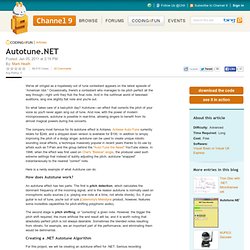
Occasionally, there's a contestant who manages to be pitch perfect all the way through—right until they flub the final note. And in the cutthroat world of televised auditions, sing one slightly flat note and you're out. So what takes care of a bad-pitch day? Autotune—an effect that corrects the pitch of your voice so you'll never again sing out of tune. And now, with the power of modern microprocessors, autotune is possible in real-time, allowing singers to benefit from its almost magical powers during live concerts. The company most famous for its autotune effect is Antares. Here is a nerdy example of what Autotune can do. How does Autotune work? An autotune effect has two parts.
The second stage is pitch shifting, or “correcting” a given note. Creating a .NET Autotune Algorithm. Open Source Code Search Engine - Black Duck Koders. How to Design Programs. Scripting Languages: PHP, Perl, Python, Ruby - Hyperpolyglot. A side-by-side reference sheet sheet one: version | grammar and execution | variables and expressions | arithmetic and logic | strings | regexes | dates and time | arrays | dictionaries | functions | execution control | exceptions | threads.

Regular-Expressions.info - Regex Tutorial, Examples and Reference - Regexp Patterns.